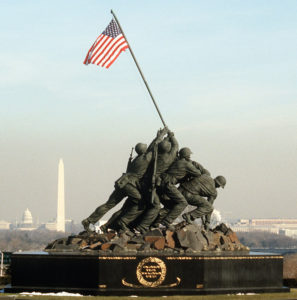
Having been stationed in Washington DC for a couple years while in the US Navy, I had the opportunity to visit most of the monuments and memorials in our nations capital. Some more than once.
Although many stood out, I was most impressed by the Marine Corps War Memorial, sometimes referred to as the Iwo Jima Memorial. How did they create those massive 32-foot tall bronze life-like figures and put it all together? There was something about it that made the word impressive seem like an understatement.
One day I found a more fitting word when my friend Neil and I were at the memorial and spoke to a man who was actually at the battle of Iwo Jima. He shared a little bit of his personal history that was not etched into the black granite base of the memorial as we stood there in the shadow of the bronze figures. Truthfully, previous to that day, as a young sailor I had no clue as to where and what the battle of Iwo Jima entailed. To me it was just a famous war story immortalized in the bronze figures of the memorial, but as I listened to the man tell his story I began to understand that peoples sincerity and life experiences cannot be replicated by objects. And so the word I found to better describe the memorial was respect.
During the invasion the man had been on an Iwo Jima beach to the northeast of Mount Suribachi, a volcano on the southern tip of the island where the flag-raising had occurred. He told me how that flag raising event uplifted his spirit in the face of all the battle mortality going on around him. It was not an easy day for the guy. As we listened to him, his wife quietly holding his hand, I could hear a horror in his voice and the sorrow he suffered for his friends, yet also the gratitude and respect for those friends and this nation.
Folks, Memorial Day is not a day to get a deal on a new refrigerator. It is a day to remember those who have sacrificed so much. And although it is all of that, it is still more. So I want to take this opportunity to also thank every living veteran and every active duty marine, sailor, and soldier that may be sitting out there in a sand CHU, berthing compartment at sea, or at home with their families and friends. I salute you for each and every day you stand post for me. You’re the best. No knee taken here.
Inspirational History Behind the Marine Corps War Memorial
It is impossible to write about the construction of the memorial without writing about the unselfish sacrifice of 6331 3rd, 4th, and 5th Division Marines who would lose their lives during the 36 days it took to secure the island of Iwo Jima. Yes that number is 6331 and includes three of the marines who were in the famous photograph the Marine Corps War Memorial was modeled after.

Taking the island of Iwo Jima was an essential step in US strategy. We had been planning bombing runs on Japanese home islands since winning Saipan. However those bombing missions were threatened not only by Japanese Zero fighter planes based on Iwo Jima, but also by early warning radio transmissions by the Japanese from Iwo Jima that were giving Tokyo two hours warning notice of our aircraft reaching their targets. Also taking the islands airstrips was vital for providing a place for our damaged bombers to land. The research I have found indicates that around 2800 of our B-29 Bombers landed on Iwo Jima after we took it from the Japanese and many of those were under emergency conditions which would have otherwise meant controlled crash ocean-ditching.
The battle for Iwo Jima, known as Operation Detachment, began with US Naval Forces shelling the island to soften it up. But the Japanese were dug so deep into a complex system of pillboxes, bunkers and tunnels that our artillery did not have the effect that had been hoped for with such intense shelling. Marine forces had to take the island yard by yard, pillbox by pillbox, and tunnel by tunnel.
On the morning of 02/19/1945 at 0902 the 4th and 5th Marine Divisions began to go ashore under little resistance. The Japanese waited until thousands had landed and then opened up a barrage of artillery that killed thousands of Marines on or within short distance of the black beach sand on that first day. The man we met at the memorial was a marine who survived that hell.
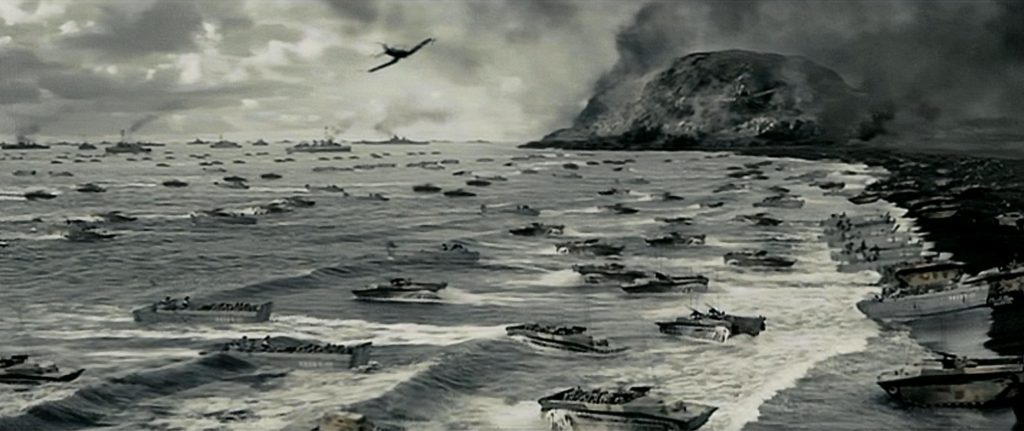
Tanks finally started arriving on the second day of the invasion. Now under the shielding of armor, they could start advancing under cover and move towards the base of Mt Suribachi a 550′ high extinct volcano on the southern tip of the pork-chop-shaped island the top of which would be planted the American flag that was famously photographed and subsequently sculpted into the Marine Corps War Memorial. But the next few days were hell on earth for those guys as they moved forward ever slowly under heavy artillery fire from bunkered Japanese positions within the mountain. They had to approach it hole-by-hole using flamethrowers, grenades and detonating explosives at hundreds of pillbox and tunnel entrances.
The First Flag Raising

First Flag Raising
Fierce perseverance found in the collective bravery of United States Jarheads brought them within reach of the Mt Suribachi summit on 2/23/1945, five days after they first hit the east side beach of Iwo Jima just north of the mountain. At 0800 a 40-man patrol began to make their way to the summit of the volcano. By 1030 they had reached the top and erected a 54″ x 28″ flag. The photo of this first flag raising was captured by a combat photographer, Marine Staff Sergeant Louis R Lowery. Although the first flag raising photograph taken on the rim of the volcano was not the famous one used for the Marine Corps War Memorial, it was the one that drew cheers from Marines, Sailors, and Coast Guardsman below at the landing beach areas and out at sea including blasts from ship horns and was an uplifting moment in the middle of a dreadful battle for many. That alert sentry in the foreground of the photo posting up with his M1 Carbine ain’t no staged event. Serious life and death business going on there.
The Second Flag Raising
Second Flag Raising
The photograph of the second flag raising was the iconic one used as the basis to sculpt the bronze figures of the Marine Corps War Memorial and was taken by Associated Press Photographer Joe Rosenthal on the same day, 02/23/1945. Accounts have it they wanted to replace it with a larger more visible flag. So a 96″ x 56″ flag was found and brought from one of the ships to the top of Suribachi.
And so at 1/400 of a second shutter speed with a lens aperture opening of between f-8 and f-11, the Pulitzer Prize winning Iwo Jima flag-raising photograph was taken. The picture went beyond viral for its day first appearing in Sunday papers worldwide only two days after it was taken on Friday 02/23/1945.
Our nation in the aftermath of reported heavy Iwo Jima US casualties, was uplifted upon seeing the photo and it became the poster pic for the largest bond drive in US history, the 7th Bond Drive, which helped finance the war.
From Photo to Plaster and Stone: The Iwo Jima Monument Precedes the Marine Corps War Memorial

Sculptor de Welden, Treasury Official, PFC Gagnon, and PFC Hayes
A US Navy Petty Officer by the name of Felix de Welden who was an aviation combat artist stationed at the Patuxent Naval Air Station, was given the photograph. Felix was an Austrian immigrant artist serving our nation. Within 72 hours he sculpted the photograph into a three dimensional scaled-down model that was four feet tall and made from wax. After seeing his work, a Marine Corps Commandant had him assigned to the Marine Corps until he was discharged when the war ended. Years later de Welden would say “I was in the middle of painting the Battle of the Coral Sea when a wire service photo came into the admiral’s office showing American Marines raising the flag over Mt. Suribachi on Iwo Jima. They came in every day, but this one, by Joe Rosenthal of AP, was extraordinary. It showed the unison of action, the forward drive, the will to sacrifice, to hold the flag high.”
Next he was asked by the secretary of the treasury to produce a nine-foot version of the Mt Surabachi flag-raising for a war bond drive. That one was a plaster and stone version which stood for a few years on Constitution Avenue in Washington DC. It was later moved to the Marine Corps base in Quantico VA. Another version that was carved out of Indiana limestone was also created by de Welden. This was called the Iwo Jima Monument.
Creation and Construction of the Marine Corps War Memorial
De Welden was commissioned in 1951 to design and create the 78′ high Marine Corps War Memorial that is now in Arlington VA. It took three years and hundreds of craftsmen and assistants to complete the job.
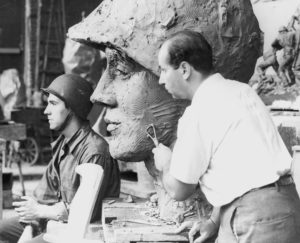
Felix de Welden Sculpts Rene Gagnon
The project started in Washington DC at the same large studio where de Welden had sculpted the 9′ tall Iwo Jima Monument mentioned in previously. There the full size plaster models were created that were to be used for bronze casting. De Welden brought in three marines used to model 3 of the figures after. Two of them, PFC Rene A. Gagnon and PFC Ira Haynes, were marines that were actually in AP Photographer Joe Rosenthals picture of the second flag-raising. PFC Harold Schults a man of great modesty and honor, was not present for the sculpting of the memorial. Also not able to be present because they were killed-in-action during the battle for Iwo Jima within days of the flag-raising on the top of Mt Suribachi were Sgt Michael Strank, Cpl Harlon H Block, and PFC Franklin R Sousley. Rest in peace this Memorial Day.
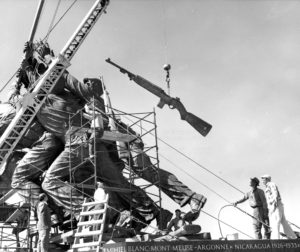
Hoisting and Placing the Bronze
After the full-sized plaster model was created, it was carefully cut and taken apart in sections and then hauled to Brooklyn New York for bronze casting. After all the parts had been cast they were cleaned and finished and chased and then reassembled into a dozen or so pieces, the largest of which weighed over 20 tons. They were then brought back to Washington DC where they were hoisted and bolted/welded together. The statue was then treated with preservatives.
Meanwhile in 1953, the Marine Corps War Memorial Foundation contracted Horace Peaslee to design the grounds and do the sitework for the memorial in Arlington. Included was parade grounds with a reviewing stand, pedestrian paths and vehicular roads, and of course parking. Markley Stevenson designed the simple plant landscape using large shade and evergreen trees. Hedging defined the plaza around the statue. John J. Earley Studios provided a special exposed aggregate concrete for the plaza, the reviewing stand and related features.
Dedication of the Marine Corps War Memorial took place on November 10, 1954, which was also the 179th birthday of the Marine Corps. President Dwight D. Eisenhower, Vice President Richard Nixon, and sculptor Felix de Weldon were present among others. Felix de Weldon also one of the attendees who gave a speech.
No taxpayer dollars were used to construct the Marine Corps War Memorial. Funding was totally provided by marines friends of marines, and members of the Naval Service. This funding was through the Marine Corps War Memorial Foundation.
2015 Award for Marine Corps War Memorial Restoration
On April 29 2015 the Marines announced at the memorial that Washington DC businessman and philanthropist David M. Rubenstein was making a $5.37 million donation to the National Park Foundation to restore the memorial.
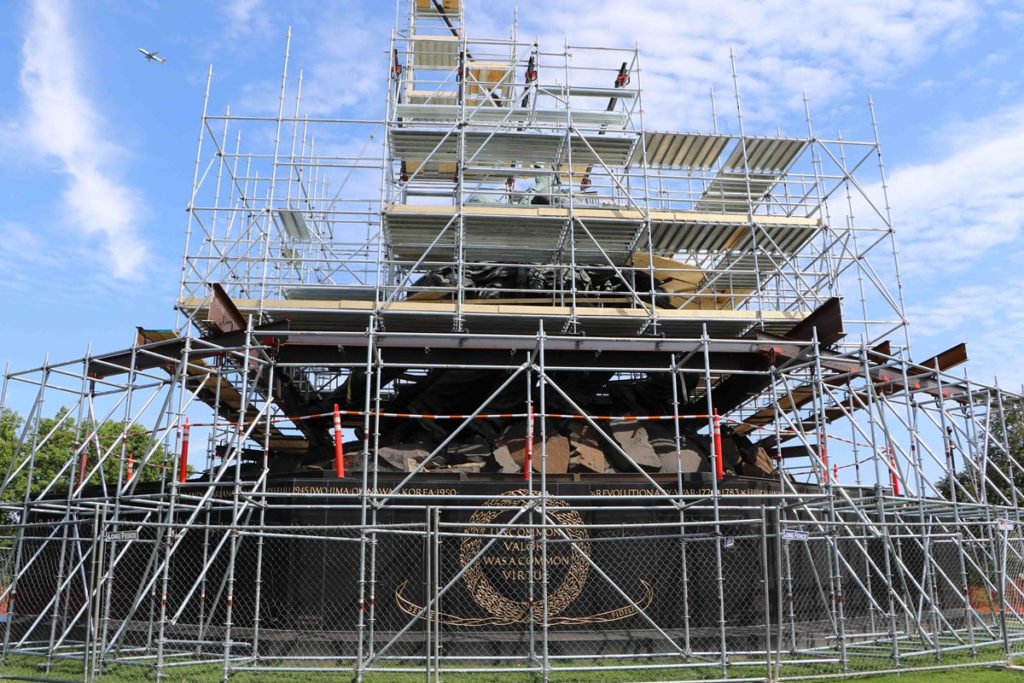
| Sculpt and Build Location | Washington DC |
| Bronze Casting Location | Brooklyn New York |
| Permanent Location | Arlington VA |
| Concrete Base | 700 tons |
| Base Surround: Bonaccord Black Diabase Highly Polished Granite from Lonsboda Sweden | 389 Tons |
| Bronze Memorial Weight | 100 Tons |
| Weight of Largest Bronze Section | 20 Tons |
| Height of bronze figures. | 32′ |
| Height of M1 Garand | 16′ |
| Height of M1 Carbine | 12′ |
| Height of Combat Knives | 5.5′ |
| Helmet Diameters | 3.5′ |
| Total Height of Memorial | 78′ |
| Length of Bronze Flagpole. | 60′ |
| Total Cost Including Site Development | $850,000 |
Building Trades Navigation
Electricians HVAC/R Techs Plumbers Other Helpful Trade Resources
Main Menu Navigation
HOME PAGE Building Trades NT Blog
